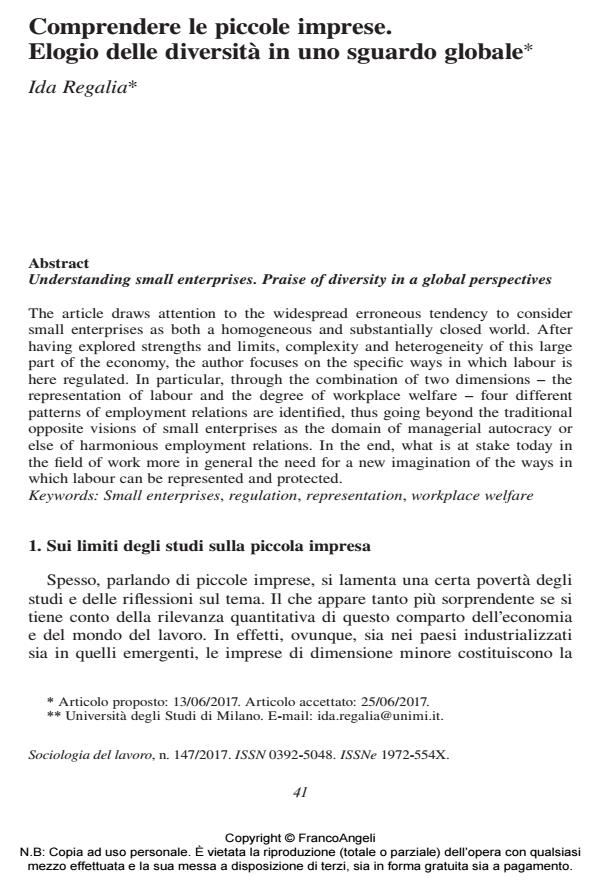Comprendere le piccole imprese. Elogio delle diversità in uno sguardo globale
Titolo Rivista SOCIOLOGIA DEL LAVORO
Autori/Curatori Ida Regalia
Anno di pubblicazione 2017 Fascicolo 2017/147
Lingua Italiano Numero pagine 18 P. 41-58 Dimensione file 124 KB
DOI 10.3280/SL2017-147003
Il DOI è il codice a barre della proprietà intellettuale: per saperne di più
clicca qui
Qui sotto puoi vedere in anteprima la prima pagina di questo articolo.
Se questo articolo ti interessa, lo puoi acquistare (e scaricare in formato pdf) seguendo le facili indicazioni per acquistare il download credit. Acquista Download Credits per scaricare questo Articolo in formato PDF

FrancoAngeli è membro della Publishers International Linking Association, Inc (PILA)associazione indipendente e non profit per facilitare (attraverso i servizi tecnologici implementati da CrossRef.org) l’accesso degli studiosi ai contenuti digitali nelle pubblicazioni professionali e scientifiche
The article draws attention to the widespread erroneous tendency to consider small enterprises as both a homogeneous and substantially closed world. After having explored strengths and limits, complexity and heterogeneity of this large part of the economy, the author focuses on the specific ways in which labour is here regulated. In particular, through the combination of two dimensions - the representation of labour and the degree of workplace welfare - four different patterns of employment relations are identified, thus going beyond the traditional opposite visions of small enterprises as the domain of managerial autocracy or else of harmonious employment relations. In the end, what is at stake today in the field of work more in general the need for a new imagination of the ways in which labour can be represented and protected.
Il saggio evidenzia come spesso si tenda erroneamente a considerare le piccole imprese un mondo omogeneo e sostanzialmente chiuso. Dopo una breve riflessione sui punti di forza e i limiti, gli elementi di complessità e di eterogeneità di questa larga parte dell’economia, l’autore sposta l’attenzione sulle specificità dei modi in cui viene regolato il lavoro al loro interno. In particolare, combinando presenza/assenza di rappresentanza del lavoro e grado di benessere lavorativo dei lavoratori, vengono individuati quattro diversi modelli di relazioni d’impiego, smentendo così le ipotesi sia di una netta prevalenza di modi di gestione unilaterale dell’impresa con condizioni insoddisfacenti per il lavoro, sia quella opposta del prevalere di situazioni armoniose e elevato benessere per i lavoratori. In definitiva, ciò che è in gioco oggi nel campo del lavoro più in generale è la necessità di immaginare nuovi modi di rappresentanza e tutela.
Parole chiave:Piccole imprese; regolazione; rappresentanza; benessere lavorativo
Ida Regalia, Comprendere le piccole imprese. Elogio delle diversità in uno sguardo globale in "SOCIOLOGIA DEL LAVORO " 147/2017, pp 41-58, DOI: 10.3280/SL2017-147003